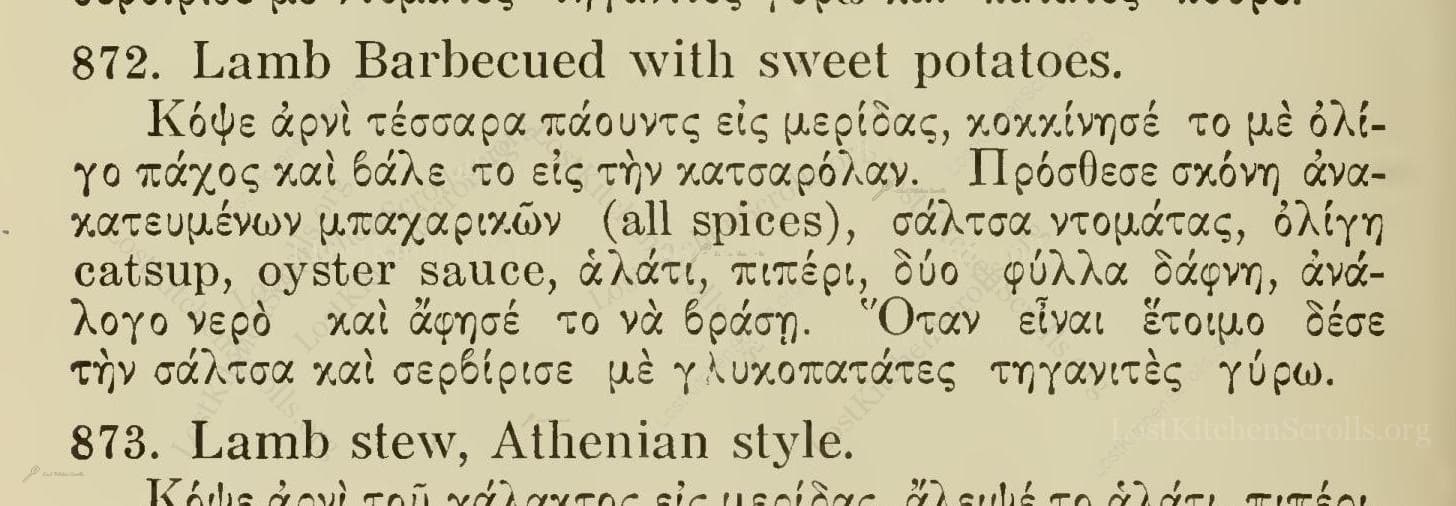Lamb Barbecued With Sweet Potatoes
"Lamb Barbecued With Sweet Potatoes"
From the treasured pages of Megale amerikanike mageirike dia mageirous kai oikogeneias
Written by Michael Gkines

Lamb Barbecued With Sweet Potatoes
"Κόψε ἀρνὶ τέσσαρα πάουντς εἰς μερίδας, κοκκίνησέ το μὲ ὀλίγο πάχος καὶ βάλε το εἰς τὴν κατσαρόλαν. Πρόσθεσε σκόνη ἀνακατευμένων μπαχαρικῶν (all spices), σάλτσα ντομάτας, ὀλίγη catsup, oyster sauce, ἁλάτι, πιπέρι, δύο φύλλα δάφνη, ἀνάλογο νερὸ καὶ ἄφησέ το νὰ βράσῃ. ῞Οταν εἶναι ἕτοιμο δέσε τὴν σάλτσα καὶ σερβίρισε μὲ γλυκοπατάτες τηγανιτὲς γύρω."
English Translation
"Cut lamb, four pounds, into portions, brown it with a little fat and put it in the pot. Add mixed spice powder (all spices), tomato sauce, a little catsup, oyster sauce, salt, pepper, two bay leaves, appropriate amount of water, and let it boil. When it is ready, thicken the sauce and serve with fried sweet potatoes around."
Note on the Original Text
Recipes of this era were written in a minimal, almost shorthand style, assuming a basic kitchen literacy. Ingredients are woven into the action, with little separation of methods and measures. Specific quantities are often vague or omitted, requiring cooks to rely on their own judgment or experience. The Greek text also features phonetic approximations of American products—such as 'catsup' for 'ketchup'—and uses the phrase 'all spices' to mean a typical mixed sweet spice blend, not a single spice as in modern terminology.

Title
Megale amerikanike mageirike dia mageirous kai oikogeneias (1917)
You can also click the book image above to peruse the original tome
Writer
Michael Gkines
Era
1917
Publisher
Ekdotika Katastemata
Background
A sumptuous journey through early 20th-century Greek-American kitchens, this cookbook offers practical and time-tested recipes for savory dishes and delightful sweets—each crafted to suit the American system, yet infused with Greek tradition. A perfect companion for both family cooks and aspiring chefs.
Kindly made available by
Internet Archive
This recipe hails from the 1917 Greek-language cookbook "Megale amerikanike mageirike..." by Michael Gkines, published in New York for America's Greek-speaking community. The collection features practical, reliably-tested recipes to bridge American culinary traditions with Greek tastes. The inclusion of ingredients like catsup (ketchup) and oyster sauce reveals the melting-pot influences of early 20th-century New York. Dishes such as this lamb stew marry Greek techniques with globally available sauces, showing early Greek immigrants adapting their cuisine in an American context.

In the early 1900s, Greek-American home cooks would have used a heavy-bottomed pot or metal casserole for stewing the lamb, likely cooked over a wood or coal stove. Knives for portioning the meat, ladles for stirring, and simple pans for frying sweet potatoes (usually in lard or oil) completed the setup. Unlike today’s non-stick equipment, the tools would have been more robust and required more attention, especially maintaining the right simmering temperature over variable heat sources.
Prep Time
30 mins
Cook Time
2 hrs
Servings
6
We've done our best to adapt this historical recipe for modern kitchens, but some details may still need refinement. We warmly welcome feedback from fellow cooks and culinary historians — your insights support the entire community!
Ingredients
- 4 lbs lamb (bone-in pieces, or shoulder preferred)
- 2 tbsp olive oil or other fat
- 2 tsp mixed spice powder (allspice, cinnamon, nutmeg, cloves)
- 14 oz tomato sauce
- 2 tbsp tomato ketchup
- 2 tbsp oyster sauce (or mushroom soy sauce as a substitute)
- 2 tsp salt
- 1 tsp black pepper
- 2 bay leaves
- 2 cups water (approximate, enough to nearly cover meat)
- Sweet potatoes, peeled and sliced for frying (about 2-3 medium, 1.3 lbs)
- Oil for frying sweet potatoes
Instructions
- Cut 4 lbs of lamb into serving pieces.
- In a large casserole or Dutch oven, brown the lamb with a little fat (about 2 tablespoons olive oil or vegetable oil).
- Once deeply browned, add 2 teaspoons mixed spice powder (a blend of allspice, cinnamon, nutmeg, and cloves), 14 oz tomato sauce (about 1.5 cups), 2 tablespoons tomato ketchup, 2 tablespoons oyster sauce, 2 teaspoons salt, 1 teaspoon freshly ground black pepper, and 2 bay leaves.
- Pour in enough water (about 2 cups) to nearly cover the lamb.
- Bring to a gentle simmer, cover, and cook for 1.5 to 2 hours, until the lamb is tender.
- When the lamb is cooked, remove the meat and thicken the sauce if needed—either by simmering uncovered or using a tablespoon of flour blended with a little water.
- Serve the lamb arranged on a platter, surrounded by crispy fried sweet potato slices.
Estimated Calories
610 per serving
Cooking Estimates
Preparing this dish takes some time for cutting the lamb and peeling sweet potatoes, then cooking the lamb until very tender. Allow extra time for frying sweet potatoes and thickening the sauce as needed. The values below help you plan how long each step takes and how many calories are in each serving.
As noted above, we have made our best effort to translate and adapt this historical recipe for modern kitchens, taking into account ingredients nowadays, cooking techniques, measurements, and so on. However, historical recipes often contain assumptions that require interpretation.
We'd love for anyone to help improve these adaptations. Community contributions are highly welcome. If you have suggestions, corrections, or cooking tips based on your experience with this recipe, please share them below.
Join the Discussion
Rate This Recipe
Dietary Preference
Main Ingredients
Culinary Technique
Occasions

Den Bockfisch In Einer Fleisch Suppen Zu Kochen
This recipe hails from a German manuscript cookbook compiled in 1696, a time whe...

Die Grieß Nudlen Zumachen
This recipe comes from a rather mysterious manuscript cookbook, penned anonymous...

Ein Boudain
This recipe comes from an anonymous German-language manuscript cookbook from 169...

Ein Gesaltzen Citroni
This recipe, dating from 1696, comes from an extensive anonymous German cookbook...
Browse our complete collection of time-honored recipes



